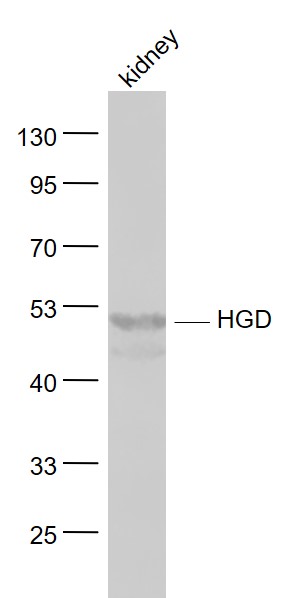HGD Rabbit pAb
HGD Rabbit pAb
- 产品详情
- 实验流程
- 背景知识
Application
| WB |
|---|---|
| Primary Accession | Q93099 |
| Reactivity | Mouse |
| Predicted | Human, Rat, Rabbit |
| Host | Rabbit |
| Clonality | Polyclonal |
| Calculated MW | 49964 Da |
| Physical State | Liquid |
| Immunogen | KLH conjugated synthetic peptide derived from human HGD |
| Epitope Specificity | 351-445/445 |
| Isotype | IgG |
| Purity | affinity purified by Protein A |
| Buffer | 0.01M TBS (pH7.4) with 1% BSA, 0.02% Proclin300 and 50% Glycerol. |
| SIMILARITY | Belongs to the homogentisate dioxygenase family. |
| DISEASE | Alkaptonuria (AKU) [MIM:203500]: An autosomal recessive error of metabolism characterized by an increase in the level of homogentisic acid. The clinical manifestations are urine that turns dark on standing and alkalinization, black ochronotic pigmentation of cartilage and collagenous tissues, and spine arthritis. Note=The disease is caused by mutations affecting the gene represented in this entry. |
| Important Note | This product as supplied is intended for research use only, not for use in human, therapeutic or diagnostic applications. |
| Background Descriptions | HGD is a 445 amino acid protein that belongs to the homogentisate dioxygenase family and is involved in the pathway of amino acid degradation. Expressed at high levels in kidney, colon, liver, prostate and small intestine, HGD uses iron as a cofactor to catalyze the oxygen-dependent conversion of homogentisate to 4-maleylacetoacetate, a reaction that is the fourth step in the creation of L-phenylalanine from fumarate and acetoacetic acid. Defects in the gene encoding HGD are the cause of alkaptonuria (AKU), an autosomal recessive disorder that is characterized by urine that turns dark on standing and alkalinization, black ochronotic pigmentation of cartilage and collagenous tissues and spine arthritis. |
| Gene ID | 3081 |
|---|---|
| Other Names | Homogentisate 1, 2-dioxygenase, 1.13.11.5, Homogentisate oxygenase, Homogentisic acid oxidase, Homogentisicase, HGD, HGO |
| Target/Specificity | Highest expression in the prostate, small intestine, colon, kidney and liver. |
| Dilution | WB=1:500-2000 |
| Storage | Store at -20 °C for one year. Avoid repeated freeze/thaw cycles. When reconstituted in sterile pH 7.4 0.01M PBS or diluent of antibody the antibody is stable for at least two weeks at 2-4 °C. |
| Name | HGD |
|---|---|
| Synonyms | HGO |
| Function | Catalyzes the conversion of homogentisate to maleylacetoacetate. |
| Tissue Location | Highest expression in the prostate, small intestine, colon, kidney and liver |
For Research Use Only. Not For Use In Diagnostic Procedures.
Provided below are standard protocols that you may find useful for product applications.
BACKGROUND
HGD is a 445 amino acid protein that belongs to the homogentisate dioxygenase family and is involved in the pathway of amino acid degradation. Expressed at high levels in kidney, colon, liver, prostate and small intestine, HGD uses iron as a cofactor to catalyze the oxygen-dependent conversion of homogentisate to 4-maleylacetoacetate, a reaction that is the fourth step in the creation of L-phenylalanine from fumarate and acetoacetic acid. Defects in the gene encoding HGD are the cause of alkaptonuria (AKU), an autosomal recessive disorder that is characterized by urine that turns dark on standing and alkalinization, black ochronotic pigmentation of cartilage and collagenous tissues and spine arthritis.
终于等到您。ABCEPTA(百远生物)抗体产品。
点击下方“我要评价 ”按钮提交您的反馈信息,您的反馈和评价是我们最宝贵的财富之一,
我们将在1-3个工作日内处理您的反馈信息。
如有疑问,联系:0512-88856768 tech-china@abcepta.com.























 癌症的基本特征包括细胞增殖、血管生成、迁移、凋亡逃避机制和细胞永生等。找到癌症发生过程中这些通路的关键标记物和对应的抗体用于检测至关重要。
癌症的基本特征包括细胞增殖、血管生成、迁移、凋亡逃避机制和细胞永生等。找到癌症发生过程中这些通路的关键标记物和对应的抗体用于检测至关重要。 为您推荐一个泛素化位点预测神器——泛素化分析工具,可以为您的蛋白的泛素化位点作出预测和评分。
为您推荐一个泛素化位点预测神器——泛素化分析工具,可以为您的蛋白的泛素化位点作出预测和评分。 细胞自噬受体图形绘图工具为你的蛋白的细胞受体结合位点作出预测和评分,识别结合到自噬通路中的蛋白是非常重要的,便于让我们理解自噬在正常生理、病理过程中的作用,如发育、细胞分化、神经退化性疾病、压力条件下、感染和癌症。
细胞自噬受体图形绘图工具为你的蛋白的细胞受体结合位点作出预测和评分,识别结合到自噬通路中的蛋白是非常重要的,便于让我们理解自噬在正常生理、病理过程中的作用,如发育、细胞分化、神经退化性疾病、压力条件下、感染和癌症。






